One of the major rolls of the Association of Zoos and Aquariums is to develop and upgrade standards for animal care. Using the collective expertise of its thousands of member keepers, veterinarians, researchers, scientists and the best minds available in academia, they created committees to manage the various species as though they were one unified collection. This allowed them to move animals between institutions in order to fill needs, and satisfy the optimal breeding recommendations. At the same time, the level of care for each species also came into play. Issues around dietary needs, a collective database of medical care and techniques developed to meet the unique needs of some species. Psychological well-being with consideration to the socialization needs of various species which also led to best practices regarding institutional population sizes and the design and size of holding facilities and habitats were also added into the comprehensive mix and rubrics by which institutions are judges regarding recommendations and accreditation.
AZA might seem like just a couple of letters attached to the logo or presented on the literature, signage and websites of members, but unlike other zoological associations, membership means meeting or realistically achieving rigorous standards. Standards that are constantly being reviewed and when necessary revised upward. Few animals have received the scrutiny that has been applied to Elephants, both Asian and African, in the development and maintenance of these high-care, state-of-the-art expectations.
In the short time that I have been associated with the AZA and aware of this process, I've witnessed how some zoos--some major American and Canadian zoological parks--have chosen to deaccession Elephants from their campuses rather than make the necessary high-cost investments to meet AZA standards or because the AZA standards create requirements of habitat design that exceed their available space to grow. Among these institutions has been the Philadelphia Zoo, the Virginia Zoo, the Woodland Park Zoo, the Calgary Zoo and the Buttonwood Park Zoo in little New Bedford, Massachusetts. The Maryland Zoo in Baltimore spent more than 12 million dollars in the 20 million dollar renovation to up-grade their decent African Elephant Habitat into one that meets new standards. The Denver Zoo completed a similar multi-million dollar up-grade as did the Smithsonian National Zoo in Washington, DC. All three are amazing. And all three are or are slated to become geriatric elephant holding facilities.
Even as a member of the AZA with lots of access to amazing information, the organization keeps the particulars of the Elephant program under wraps because of how some reactionary animal rights groups have used the care of these animals as a cause to create uproar and fund-raise.
But back to the Cleveland Metro Zoo's African Elephant Crossing. The multi acre habitat featured two large exterior areas and potentially smaller spaces that can be cordoned off when necessary. There is a central plaza that gives viewing opportunities to both as well as access to the Elephant Barn. Inside the barn are areas where the African Bush Elephants may be viewed during inclement weather and colder seasons. This space contains education displays and interactive models pertinent to the lives of African Bush Elephants. There are also habitats for Naked Mole Rats and African Rock Pythons--adjacent species. Out in the plaza are gift shops, food court and seating options (all of which were not open--on July 4th!? That was odd.) Also there is a colony of Slender-tailed Meerkats.
This opportunity coupled with a similar experience at the Pittsburgh Zoo the day before, are the most I've seen African Bush Elephants well cared for and engaged socially in a while. They are amazing creatures. Whatever we can do to support their quality of life and survival in the wild is our legacy to the future.
Loxadonta africanus












No comments:
Post a Comment